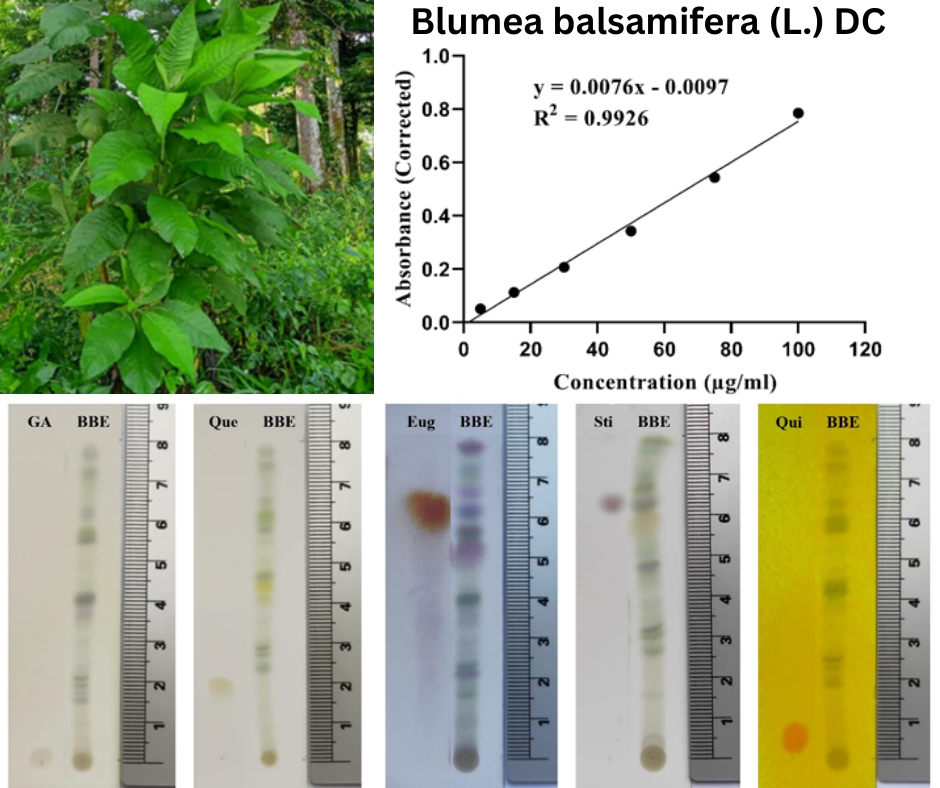Specific and nonspecific characteristics of the leaf extract of Blumea balsamifera originated from East Java, Indonesia
DOI:
https://doi.org/10.29303/aca.v7i1.178Keywords:
Blumea balsamifera, extract, flavonoids, phenolics, standardizationAbstract
Blumea balsamifera extract has been shown to have biological activities such as anti-fungal, anti-tumor, radical scavenger, anti-obesity, hepatoprotective, antioxidant, anti-microbial, anti-inflammatory, antiplasmodial, and wound healing. The quality and efficacy of B. balsamifera extract are determined by its specific and nonspecific characteristics. This study explored the characteristics of B. balsamifera extract through a series of standardization processes. The dried leaves of B. balsamifera were powdered and macerated with 70% ethanol. After the solvent evaporation, a thick extract was obtained and stored in a refrigerator. The specific characteristics tested were organoleptic evaluation, total phenolic content (Folin-Ciocalteu method), total flavonoid content (aluminium chloride colorimetric method), and phytochemical screening using thin layer chromatography. The nonspecific characteristics tested were extraction yield, moisture content, total ash content, and acid-insoluble ash. The results of the study showed that the extraction process resulted in a yield of 13.4%. The extract had a thick and sticky appearance, a dark brown colour, a characteristic aroma, and a bitter taste. The moisture content, total ash content, acid-insoluble ash content, total phenolic content, and total flavonoid content of the extract were found to be 8.33±0.57 %ml/g, 11.63±0.86 %g/g, 2.26±0.12 %g/g, 43.86±0.89 mg GAE/g extract and 25.48±0.42 mg QE/g extract, respectively. Analysis using thin layer chromatography demonstrated that the extract included phenolics, flavonoids, terpenoids, and steroids.
Downloads
Metrics
References
Thongphichai, W., Uttarawichien, T., Chanvorachote, P., Pitiporn, S., Charoen-ame, T., Kwankhao, P., Towiwat, P., & Sukrong, S. (2022). Standardization of the ethanolic extract of Crinum latifolium leaves by two bioactive markers with antiproliferative activity against TGF-β-promoted prostate stromal cells (WPMY-1). BMC Complementary Medicine and Therapies, 22(1), 139. https://doi.org/10.1186/s12906-022-03617-x
Bilia, A. R. (2014). Science meets regulation. Journal of Ethnopharmacology, 158, 487–494. https://doi.org/10.1016/j.jep.2014.06.036
Li, S., Han, Q., Qiao, C., Song, J., Lung Cheng, C., & Xu, H. (2008). Chemical markers for the quality control of herbal medicines: An overview. Chinese Medicine, 3(1), 7. https://doi.org/10.1186/1749-8546-3-7
Singh, R. (2015). Medicinal plants: A review. Journal of Plant Sciences, 3(1), 50–55. https://doi.org/10.11648/j.jps.s.2015030101.18
Dali, N., Dali, A., Dali, S., Chairunnas, A., Amalia, H. A. M., & Puspitasari, S. A. A. (2022). Antifungal activity test of the ethanol extract of Kaembu-embu (Blumea balsamifera) leaves against Candida albicans growth. Alchemy: Journal of Chemistry, 10(2), 76–83.
Saewan, N., Koysomboon, S., & Chantrapromma, K. (2011). Anti-tyrosinase and anti-cancer activities of flavonoids from Blumea balsamifera DC. Journal of Medicinal Plants Research, 5(6), 1018–1025.
Rao, A. M. (2021). In vitro antioxidant and anticancer activity of Blumea lacera leaf extract. Journal of Biotech Research, 12, 168–176.
Roy, K., Saha, S., Biswas, S., Ahmed, W., & Mariappan, G. (2013). In vivo assessment of antidiabetic and antioxidant activities of Blumea balsamifera in streptozotocin-diabetic rats. Research Journal of Medicinal Plants, 7(1), 48–57. https://doi.org/10.3923/rjmp.2013.48.57
Xia, Y., Zuo, J., Li, X., & Chen, J. (2014). Antihyperglycemic effect of various fractions from residues of Blumea balsamifera. Chinese Herbal Medicines, 6(2), 136–139. https://doi.org/10.1016/S1674-6384(14)60021-6
Rawati, S., Ginting, B., Maulana, I., Yahya, M., Saidi, N., Murniana, & Hasballah, K. (2023). Phytochemical, antioxidant, and cytotoxicity screenings of n-hexane extract from Blumea balsamifera L leaves. Research Journal of Pharmacy and Technology, 16(4), 1664–1668. https://doi.org/10.52711/0974-360X.2023.00272
Kusumawati, I. G. A. W., & Yogeswara, I. B. A. (2016). Antioxidant and antibacterial capacity of loloh sembung (Blumea balsamifera) based on extraction method. Traditional Medicine Journal, 21(143–148), 143–148.
Liao, J., Xie, X., Wang, W., Gao, Y., Cai, Y., Peng, J., Li, T., Yi, Q., He, C., & Wang, L. (2021). Anti-inflammatory activity of essential oil from leaves of Blumea balsamifera (L.) DC through inhibiting TLR4/NF-kB signaling pathways and NLRP3 inflammasome activation in LPS-induced RAW264.7 macrophage cells. Journal of Essential Oil Bearing Plants, 24(2), 160–176. https://doi.org/10.1080/0972060X.2021.1912645
Chaniad, P., Phuwajaroanpong, A., Techarang, T., Viriyavejakul, P., Chukaew, A., & Punsawad, C. (2022). Antiplasmodial activity and cytotoxicity of plant extracts from the Asteraceae and Rubiaceae families. Heliyon, 8(1), e08848. https://doi.org/10.1016/j.heliyon.2022.e08848
Pang, Y., Zhang, Y., Huang, L., Xu, L., Wang, K., Wang, D., Guan, L., Zhang, Y., Yu, F., Chen, Z., & Xie, X. (2017). Effects and Mechanisms of total flavonoids from Blumea balsamifera (L.) DC. on skin wound in rats. International Journal of Molecular Sciences, 18(12), 2766. https://doi.org/10.3390/ijms18122766
Pang, Y., Wang, D., Fan, Z., Chen, X., Yu, F., Hu, X., Wang, K., & Yuan, L. (2014). Blumea balsamifera—A Phytochemical and Pharmacological Review. Molecules, 19(7), 9453–9477. https://doi.org/10.3390/molecules19079453
Utami, Y. P., Taebe, B., & Fatmawati. (2016). Standardisasi parameter spesifik dan non spesifik ekstrak etanol daun murbei (Morus alba L.) asal Kabupaten Soppeng Provinsi Sulawesi Selatan. Journal of Pharmaceutical and Medicinal Sciences, 1(2), 48–52.
Depkes RI. (2017). Farmakope Herbal Indonesia (II). Kementrian Kesehatan Republik Indonesia.
Putra, I. M. W. A., Fakhrudin, N., Kusumawati, I. G. A. W., Nurrochmad, A., & Wahyuono, S. (2022). Antioxidant properties of extract combination of Coccinia grandis and Blumea balsamifera: An in vitro synergistic effect. Journal of Herbmed Pharmacology, 11(1), 55–62. https://doi.org/10.34172/jhp.2022.06
Putra, I. M. W. A., Kusumawati, I. G. A. W., & Sumadewi, N. L. U. (2021). Physical characteristics, total phenolic, and flavonoid content of Coccinia grandis (L.) Voigt leaves extract. Acta Chimica Asiana, 4(2), Article 2. https://doi.org/10.29303/aca.v4i2.66
Pathak, A. V., Kawtikwar, P. S., & Sakarkar, D. M. (2015). Pharmacognostical and physico-chemical standardization of Shatavari churna: An official ayurvedic formulation. Research Journal of Pharmacy and Technology, 8(11), 1495–1501. https://doi.org/10.5958/0974-360X.2015.00267.X
Gayatri, S., Monisha, S., Mythili, K., & Chitra, K. (2018). Standardization and quality control studies of agastya rasayanam-An ayurvedic drug for asthma. Research Journal of Pharmacy and Technology, 11(6), 2271–2275. https://doi.org/10.5958/0974-360X.2018.00421.3
WHO. (2011). Quality control methods for herbal materials (Updated edition of Quality control methods for medicinal plant materials, 1998). World Health Organization.
Bezerra, A. N. S., Massing, L. T., de Oliveira, R. B., & Mourão, R. H. V. (2017). Standardization and anti-inflammatory activity of aqueous extract of Psittacanthus plagiophyllus Eichl. (Loranthaceae). Journal of Ethnopharmacology, 202, 234–240. https://doi.org/10.1016/j.jep.2017.03.029
Kunle, O. F., Egharevba, H. O., & Ahmadu, P. O. (2012). Standardization of herbal medicines—A review. International Journal of Biodiversity and Conservation, 4(3), 101–112. https://doi.org/10.5897/IJBC11.163
Eriadi, A., & Alfiah, S. (2019). Uji toksisitas sub akut ekstrak etanol daun sembung (Blumea balsamifera L. DC) terhadap fungsi hati dan ginjal pada mencit putih jantan. 11(1), 9.
Dao, N. L. A., Phu, T. M., Douny, C., Quetin-Leclercq, J., Hue, B. T. B., Bach, L. T., Quynh Nhu, T., Thi Bich Hang, B., Thi Thanh Huong, D., Thanh Phuong, N., Kestemont, P., & Scippo, M.-L. (2020). Screening and comparative study of in vitro antioxidant and antimicrobial activities of ethanolic extracts of selected Vietnamese plants. International Journal of Food Properties, 23(1), 481–496. https://doi.org/10.1080/10942912.2020.1737541
Thach, B. Đ., Dao, V. Q., Giang, T. T. L., Cang, D. T., Linh, L. N. T., Ben, T., Uyen, N. P. A., & Suong, N. K. (2017). Antioxidant and antityrosinase activities of flavonoid from Blumea balsamifera (L.) DC. leaves extract. European Journal of Research in Medical Sciences, 5(1), 1–6.
Widhiantara, I. G., Permatasari, A. A. A. P., Rosiana, I. W., Wiradana, P. A., Widiastini, L. P., & Jawi, I. M. (2021). Antihypercholesterolemic and antioxidant effects of Blumea balsamifera L. leaf Extracts to maintain luteinizing hormone secretion in rats induced by high-cholesterol diets. The Indonesian Biomedical Journal, 13(4), 396–402. https://doi.org/10.18585/inabj.v13i4.1694
Masyudi, M., Hanafiah, M., Rinidar, R., Usman, S., & Marlina, M. (2022). Phytochemical screening and GC-MS analysis of bioactive compounds of Blumea balsamifera leaf extracts from South Aceh, Indonesia. Biodiversitas Journal of Biological Diversity, 23(3). https://doi.org/10.13057/biodiv/d230319
Darfiah, D., Kasmiati, K., & Latama, G. (2021). Antibacterial activity and identification of active compounds of seaweed extract Sargassum sp., Halimeda opuntia and Halymenia sp. From Lae-Lae Island of South Sulawesi. International Journal of Environment, Agriculture and Biotechnology, 6(6), 187–195. https://doi.org/10.22161/ijeab.66.23
Tambunan, A. P., Bahtiar, A., & Tjandrawinata, R. R. (2017). Influence of extraction parameters on the yield, phytochemical, TLC-densitometric quantification of quercetin, and LC-MS profile, and how to standardize different batches for long term from Ageratum conyoides L. Leaves. Pharmacognosy Journal, 9(6), 767–774. https://doi.org/10.5530/pj.2017.6.121
Syukri, Y., Purwati, R., Hazami, N., Anshory Tahmid, H., & Fitria, A. (2020). Standardization of specific and non-specific parameters of propolis extract as raw material for herbal product. EKSAKTA: Journal of Sciences and Data Analysis, 36–43. https://doi.org/10.20885/EKSAKTA.vol1.iss1.art6
Zainab, Gunanti, F., Witasari, H. A., Edityaningrum, C. A., Mustofa, & Murrukmihadi, M. (2016). Penetapan parameter standarisasi non spesifik ekstrak etanol daun belimbing wuluh (Averrhoa bilimbi L.). Rakernas dan PIT Ikatan Apoteker Indonesia, 1, 210–214.

Downloads
Published
How to Cite
Issue
Section
License
Copyright (c) 2024 I Made Wisnu Adhi Putra, I Made Gde Sudyadnyana Sandhika

This work is licensed under a Creative Commons Attribution-NonCommercial-ShareAlike 4.0 International License.
Authors who publish with ACA: Acta Chimica Asiana agree to the following terms:
- Authors retain copyright and grant the journal right of first publication with the work simultaneously licensed under a Creative Commons Attribution-NonCommercial-ShareAlike 4.0 International License. This license allows authors to use all articles, data sets, graphics, and appendices in data mining applications, search engines, web sites, blogs, and other platforms by providing an appropriate reference. The journal allows the author(s) to hold the copyright without restrictions and will retain publishing rights without restrictions.
- Authors are able to enter into separate, additional contractual arrangements for the non-exclusive distribution of the journal's published version of the work (e.g., post it to an institutional repository or publish it in a book), with an acknowledgement of its initial publication in ACA: Acta Chimica Asiana.
- Authors are permitted and encouraged to post their work online (e.g., in institutional repositories or on their website) prior to and during the submission process, as it can lead to productive exchanges, as well as earlier and greater citation of published work (See The Effect of Open Access).







